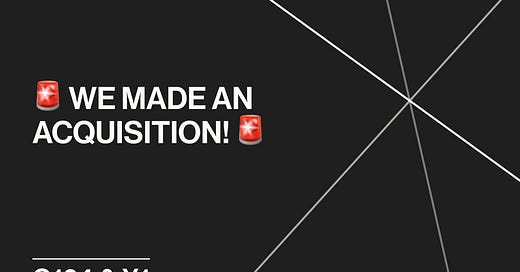🏴☠️ ⚡️ Issue #8: 🚨 We made an acquisition! 🚨
Welcome! This newsletter is dedicated to acquiring and operating Micro SaaS firms. Join us every other Saturday morning for deal analysis, operating frameworks / templates, and other musings...
Yeeehaaaaah!
I am beyond excited to announce our first acquisition: a business management SaaS for creative small and mid-sized businesses (SMBs) with a long history of profitable operations, deeply loyal customers, and tremendous potential.
Rest assured, we will continue to build in public, though we’ve chosen to maintain anonymity when it comes to our portfolio. As the saying goes, “true 🥷’s move in silence”…
With that, read on to learn more about the following:
THESIS SUMMARY
IDENTIFIED OPPORTUNITIES
TRANSFORMATION PLAN
It goes without saying, we are quite eager to begin building and operating. An acquisition is exciting validation that we can indeed play the private equity game on our own terms. However, in the grand scheme, we have achieved very little. The scoreboard is only concerned with results and value creation. It’s time to get busy…
More to come!
🎯 ACQUIRE
// THESIS SUMMARY
ELITE CUSTOMER RETENTION - Despite a noticeable YoY decline (~8%) in Annual Recurring Revenues (ARR), FIRM has maintained an average of 98.5% customer retention over the trailing 24mths, which places FIRM in the top quartile relative to comparable firms generating $0 to $25k Monthly Recurring Revenue (MRR). Lastly, customer cohort analysis (grouping customers by the month they signed on to see patterns over time) further validates retention rates are product utility are stable.
FEATURE PARITY WITH CATEGORY LEADERS - The SELLER was himself a participant in the category and has led all customer interactions for many years. As a result of this tight feedback loop and empathy for the market, SELLER has established FIRM as a feature-rich web and mobile app, on par and undeniably competitive with far better-funded and resourced competitors.
VERY STRONG REPUTATION - FIRM has near-perfect customer review ratings (4.9 stars) on Capterra and G2.
NEGLIGIBLE INVESTMENT IN CUSTOMER ACQUISITION - Investments in marketing and paid acquisition were reduced from 12% of ARR in 2020 to 1.9% in the TTM. Given the exceptional lifetime value of customers (+$1k), there is healthy margin to test and establish new acquisition channels.
// IDENTIFIED OPPORTUNITIES
NEW INFRASTRUCTURE WILL ENABLE DATA-DRIVEN DECISIONING - There is no tooling in place today to measure user behavior within the product, which would unlock key insights re the most impactful features and the attributes of the most engaged customers to then inform criteria for data-driven customer acquisition campaigns.
MAP PRICING PLANS TO VALUE METRICS BASED ON CUSTOMER SEGMENTS: Further to the above, usage data is critical for informing packaging (grouping features together at a respective cost). ‘Too many features’ is the leading cause of customer churn and a common result of failure to prescriptively package and price plans according to use cases and ideal customer profiles (eg smaller / less complex customers need a basic package).
SEQUENCE TRIAL ONBOARDING BASED ON ‘AHA MOMENTS’ - Today, user onboarding is one comprehensive guided tour with no actions required from the user. This is a departure from best practice, which requires sequencing onboarding activities based on the behaviors that will create immediate value for the new customer. For instance, sending invoices is an acute pain point for FIRM’s customers (as we identified from product usage data for best fit customers). The first onboarding sequence should map to that outcome.
MODERNIZE CUSTOMER SUPPORT FUNCTION - SELLER has struggled to produce support documentation at the pace of product releases and enhancements. Filling these gaps would address ~15% of the most common support tickets. In addition, there are obvious patterns in the most frequently asked questions. Refreshing this content, leveraging the wide range of SOP tooling that’s out there, should reduce overall ticket volume and radically change the support cost structure.
// TRANSFORMATION PLAN
STRATEGIC PILLARS & SEQUENCING:
Modernize infrastructure to establish a data-driven operating model
Optimize later-stage funnel conversions (trial to paid) and user retention (fixate on Month 2)
Scale top of funnel via targeted outbound campaigns and paid ads, sending more volume through a now optimized acquisition funnel
30 DAY OKRs:
Objective #1: Refresh operational technology stack to modernize infrastructure
Key Results:
Implement product usage analytics (e.g. Innertrends, Segment, etc.)
Establish base rate adoption and retention metrics
Implement CRM and enrich customer profiles with firmographic and technographic data to identify patterns in best-fit customers
Implement modern service hub and chatbot to resolve support issues in real-time within the application
Objective #2: Systemetize customer support ticket resolution
Key Results:
Create support content that maps to new onboarding sequence
Identify modules and features with greatest support ticket volume, refresh documentation
Full knowledge base relaunch (with search and chat capabilities)
60 DAY OKRs:
Objective #3: Accelerate time to value during onboarding
Key Results:
Implement in-app onboarding guide and craft associated email drip campaigns based on value metrics derived from product usage data and user feedback
20% improvement in trial to paid conversion rate
>80% user retention in month 2
Objective #4: Refresh website and buyer journey
Key Results:
Validate jobs to be done and value prop statements for most common ideal customer profile (ICP)
Launch new website with buyer journey and messaging mapped to ICP #1
Launch landing pages that map to outbound campaigns and offers
Objective #5: Refactor Pricing / packaging
Key Results:
Validate value metric and pricing container
Align feature bundles and pricing to the value metrics and associated tier of customer needs







